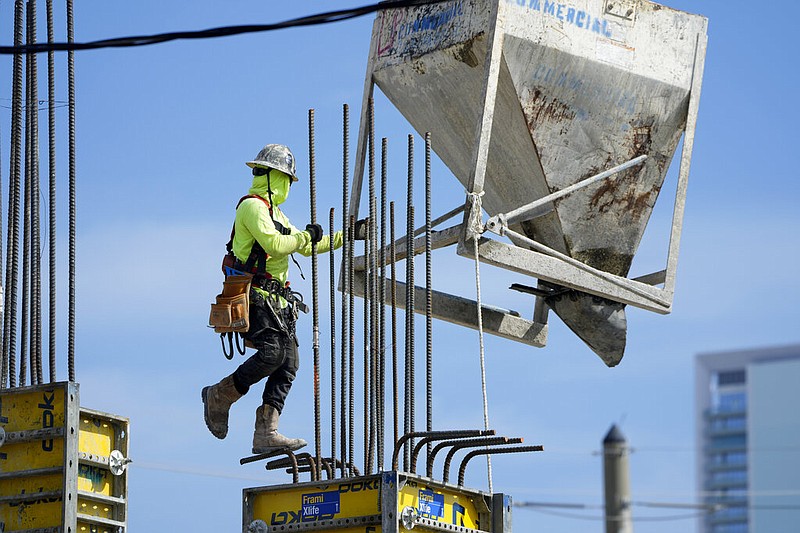The U.S. economy expanded at a healthy pace in the final three months of 2022, though signs of slowing consumer spending mounted as the steepest interest rate increases by the Federal Reserve in decades threaten growth this year.
Gross domestic product in the United States -- the broadest measure of the economy -- increased at an annual rate of 2.9% in the fourth quarter, the Commerce Department's initial estimate showed Thursday. Although beating expectations, that's down slightly from GDP growth of 3.2% in the previous three months.
Consumer spending, the bedrock of the U.S. economy, grew at a below-forecast rate of 2.1%, according to the agency. Median projections in a Bloomberg survey of economists called for a 2.6% rise in GDP and a 2.9% advance in spending.
About half of the GDP increase reflected inventory growth, while government spending matched its biggest gain since early 2021, according to the Commerce Department.
Stocks climbed Thursday to send Wall Street to its highest level in nearly eight weeks after the data was released, helped also by positive corporate earnings reports. The S&P 500 climbed 1.1% to clinch its highest finish since Dec. 2. The Dow Jones Industrial Average gained 0.6%, while the Nasdaq composite rallied 1.8% on the day.
But most economists think the U.S. economy will slow further in the current quarter and slide into at least a mild recession by midyear. The data released Thursday is preliminary and will be revised at least twice in the coming months.
The healthy fourth-quarter growth capped a year in which economic output contracted in the first half of 2022, prompting talk of a technical recession, and then rebounded.
"The economy continued to motor on," said Michael Gapen, chief U.S. economist for Bank of America. "There's more momentum in the economy at year-end than we thought."
Throughout 2022, as measured from the fourth quarter a year earlier, GDP grew 1% annually, down sharply from 5.7% growth in 2021. The seesaw pattern in 2022 was driven by big swings in trade and inventories, historically the most volatile components of GDP.
The bigger picture, economists say, was simpler: Recovery from the covid-19 recession has cooled from the frenetic pace of 2021 but has remained resilient in the face of war in Europe, global inflation and the aggressive series of interest rate increases by the Fed at home.
"2020 was the pandemic. 2021 was the bounce back from the pandemic. 2022 was a transition year," said Jay Bryson, chief economist for Wells Fargo. "It will go in the history books as an OK year."
The question now is whether that resilience can continue in 2023.
Inflation remains too high by many measures, and the Fed is expected to continue increasing rates in an effort to bring prices under control.
Year-over-year consumer inflation was raging at a 9.1% rate in June, the highest level in more than 40 years. The rate has since cooled -- to 6.5% in December -- but remains far above the Fed's 2% annual target.
A congressional showdown over raising the U.S. debt ceiling, meanwhile, could cause further turmoil in financial markets -- or a crisis, if lawmakers fail to reach a deal.
Signs of economic strain are already apparent, especially in sectors most sensitive to higher borrowing costs from the Fed's rate increases.
Construction activity and home sales have slowed significantly, for example. Tech companies have announced tens of thousands of layoffs in recent weeks. And manufacturing output fell in November and December.
Even the reliable consumer-spending engine -- fueling some 70% of the entire economy -- may be starting to sputter.
Retail sales have fallen for two straight months now, and Americans are increasingly turning to credit cards as pandemic-era savings dry up.
"The savings rate has continued to come down," Bryson said. "Credit card debt continues to rise. Those trends -- they're not sustainable. It seems like consumers are continuing to run on borrowed time."
Economists at Bank of America expect GDP growth to slow to a 1.5% annual rate in the current January-March quarter, and then contract for the rest of the year -- by a 0.5% rate in the second quarter, 2% in the third and 1.5% in the fourth.
On corporate earnings calls for the April-June quarter of 2022, nearly half of companies listed in the S&P 500 had cited an incoming "recession" -- the highest such proportion since 2010 -- according to the data provider FactSet.
But others say a recession this year is not inevitable. Inflation has begun to ease in recent months, even as the unemployment rate has remained low, at 3.5% in December. Easing inflation and strong employment could allow the Fed to raise rates more slowly, reducing the risk of a recession.
"We've seen good news on inflation even with the labor market staying strong," said Wendy Edelberg, director of the Hamilton Project, an economic policy arm of the Brookings Institution. "Now monetary policy can be a little more patient."
Information for this article was contributed by Ben Casselman of The New York Times, Augusta Saraiva of Bloomberg News (WPNS), and Paul Wiseman and Stan Choe of The Associated Press.

